Cloud Computing: Exploring Service Models, Architecture and Trends
VerifiedAdded on 2023/06/11
|15
|1030
|418
Report
AI Summary
This report provides an overview of cloud computing, starting with its definition and historical context. It then delves into the three primary service models: Infrastructure as a Service (IaaS), Platform as a Service (PaaS), and Software as a Service (SaaS), explaining their functionalities and differences. The report also outlines various deployment models, including public, private, and hybrid clouds. A significant portion of the report is dedicated to cloud computing architecture, highlighting the components and their interactions. Security and privacy concerns are addressed, including potential data breaches and the importance of data encryption. Finally, the report explores emerging trends in cloud computing and discusses limitations such as security risks, limited flexibility, platform dependencies, and potential downtime. The document is available on Desklib, where students can find more solved assignments and study resources.

CLOUD COMPUTING
Cloud computing refers to an IT (Information
Technology) paradigm which enables ubiquitous
means of entry to communal pools of consignable
system resources and services of high levels which
can be provisioned rapidly with minimal
supervisory efforts, normally over the internet. It
relies on sharing of resources to accomplish
economies of scale and coherence, just like in
public utility.
Cloud computing refers to an IT (Information
Technology) paradigm which enables ubiquitous
means of entry to communal pools of consignable
system resources and services of high levels which
can be provisioned rapidly with minimal
supervisory efforts, normally over the internet. It
relies on sharing of resources to accomplish
economies of scale and coherence, just like in
public utility.
Paraphrase This Document
Need a fresh take? Get an instant paraphrase of this document with our AI Paraphraser
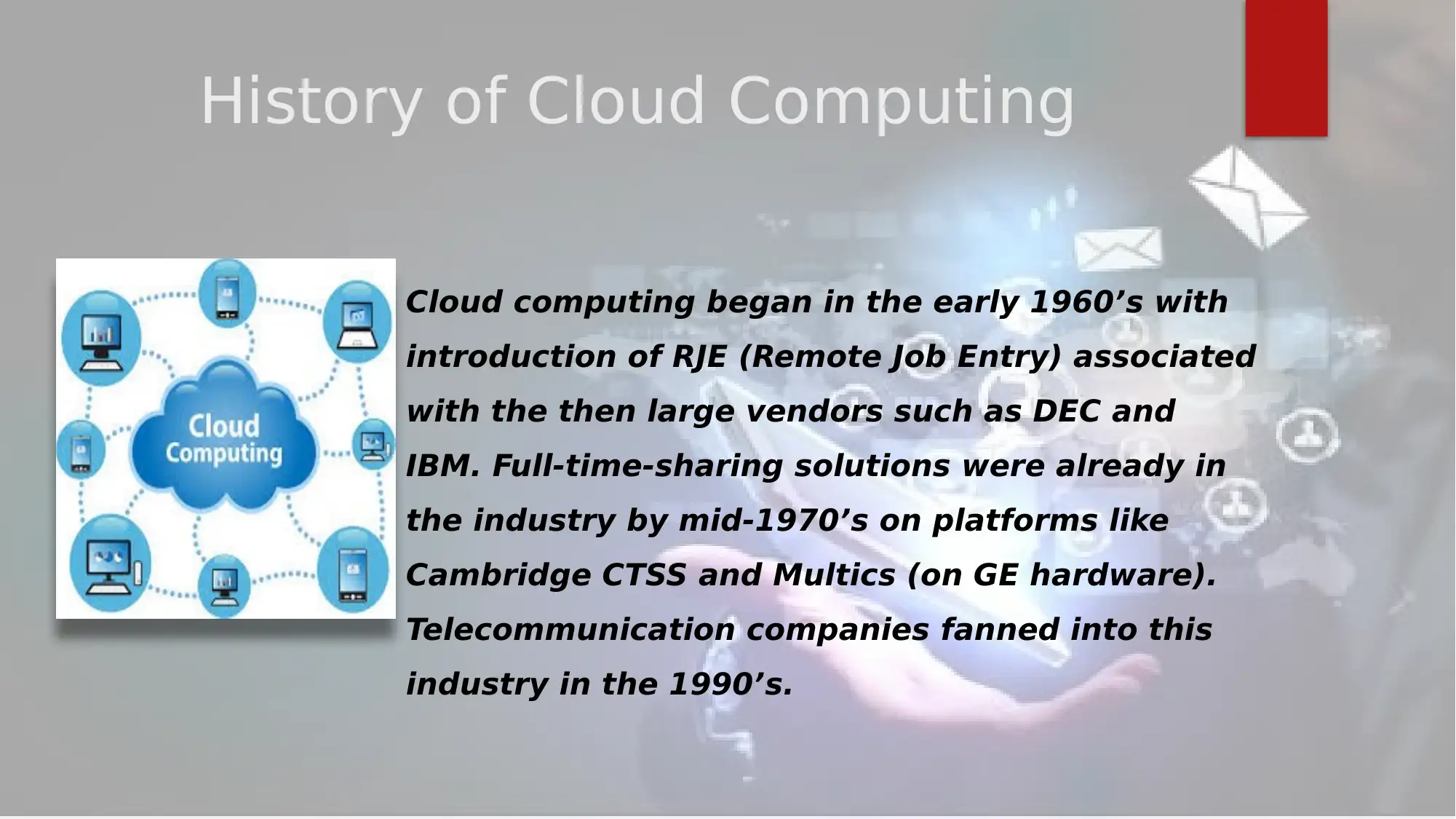
History of Cloud Computing
Cloud computing began in the early 1960’s with
introduction of RJE (Remote Job Entry) associated
with the then large vendors such as DEC and
IBM. Full-time-sharing solutions were already in
the industry by mid-1970’s on platforms like
Cambridge CTSS and Multics (on GE hardware).
Telecommunication companies fanned into this
industry in the 1990’s.
Cloud computing began in the early 1960’s with
introduction of RJE (Remote Job Entry) associated
with the then large vendors such as DEC and
IBM. Full-time-sharing solutions were already in
the industry by mid-1970’s on platforms like
Cambridge CTSS and Multics (on GE hardware).
Telecommunication companies fanned into this
industry in the 1990’s.
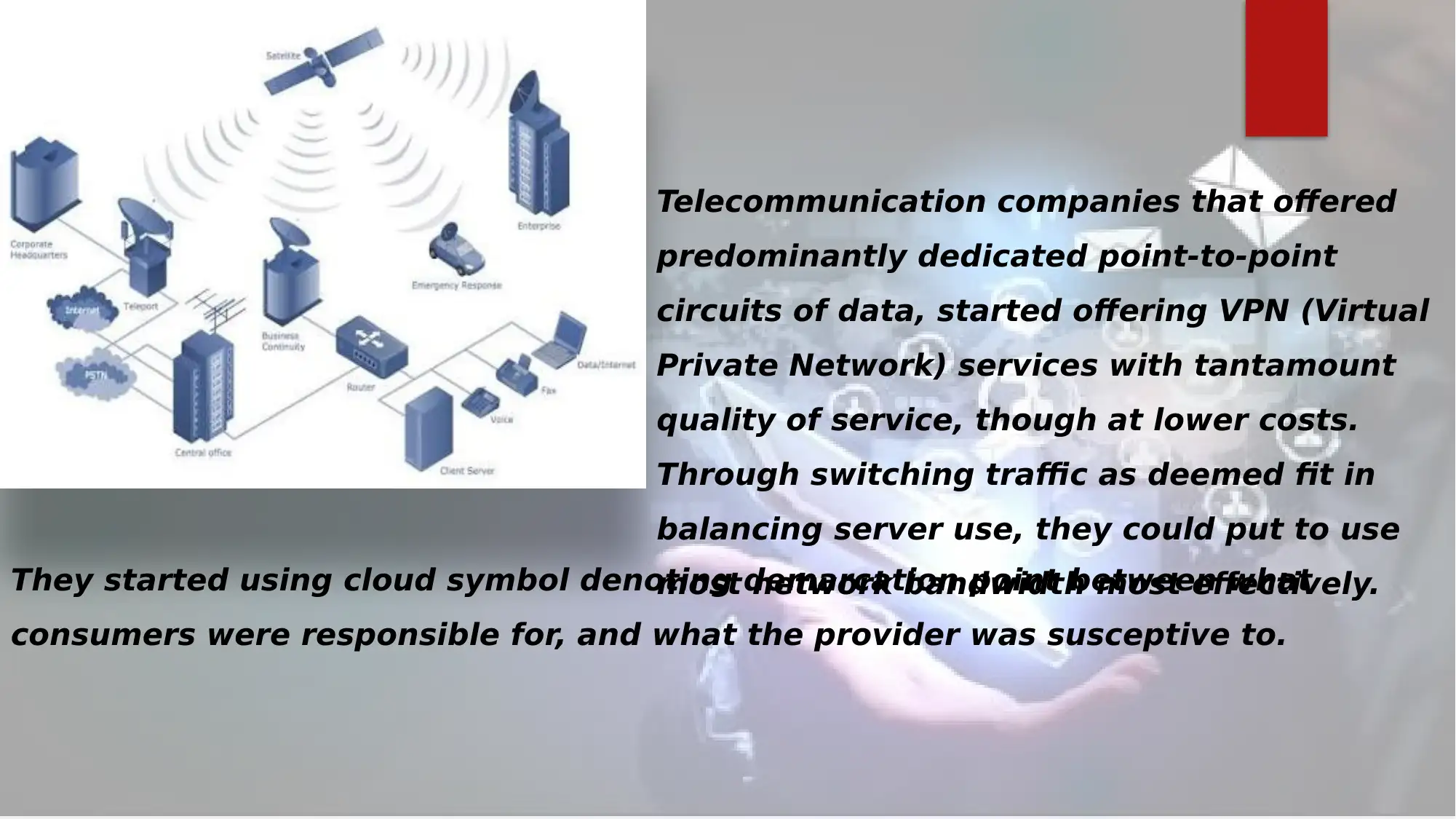
Telecommunication companies that offered
predominantly dedicated point-to-point
circuits of data, started offering VPN (Virtual
Private Network) services with tantamount
quality of service, though at lower costs.
Through switching traffic as deemed fit in
balancing server use, they could put to use
most network bandwidth most effectively.They started using cloud symbol denoting demarcation point between what
consumers were responsible for, and what the provider was susceptive to.
predominantly dedicated point-to-point
circuits of data, started offering VPN (Virtual
Private Network) services with tantamount
quality of service, though at lower costs.
Through switching traffic as deemed fit in
balancing server use, they could put to use
most network bandwidth most effectively.They started using cloud symbol denoting demarcation point between what
consumers were responsible for, and what the provider was susceptive to.
⊘ This is a preview!⊘
Do you want full access?
Subscribe today to unlock all pages.

Trusted by 1+ million students worldwide
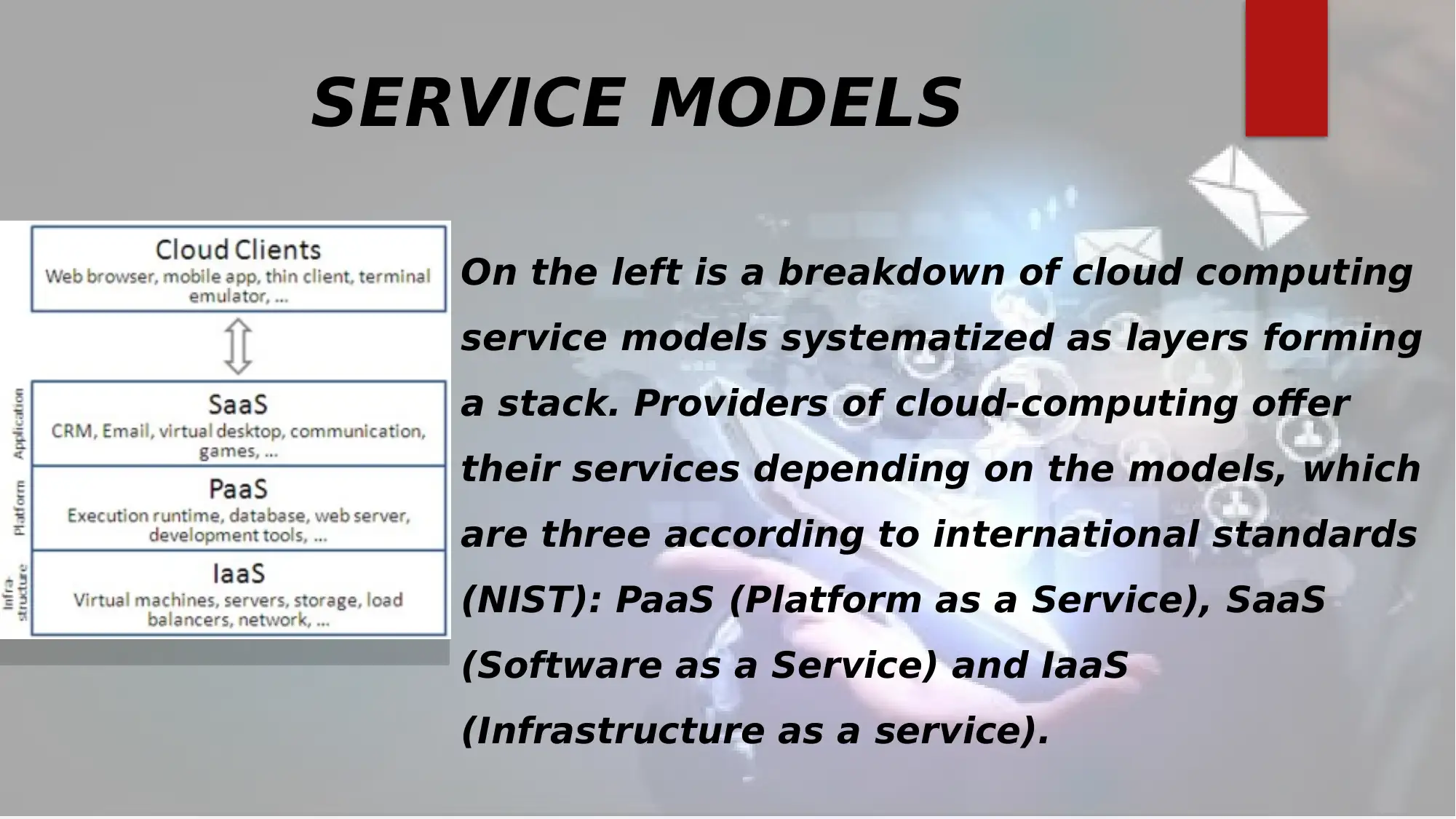
SERVICE MODELS
On the left is a breakdown of cloud computing
service models systematized as layers forming
a stack. Providers of cloud-computing offer
their services depending on the models, which
are three according to international standards
(NIST): PaaS (Platform as a Service), SaaS
(Software as a Service) and IaaS
(Infrastructure as a service).
On the left is a breakdown of cloud computing
service models systematized as layers forming
a stack. Providers of cloud-computing offer
their services depending on the models, which
are three according to international standards
(NIST): PaaS (Platform as a Service), SaaS
(Software as a Service) and IaaS
(Infrastructure as a service).
Paraphrase This Document
Need a fresh take? Get an instant paraphrase of this document with our AI Paraphraser
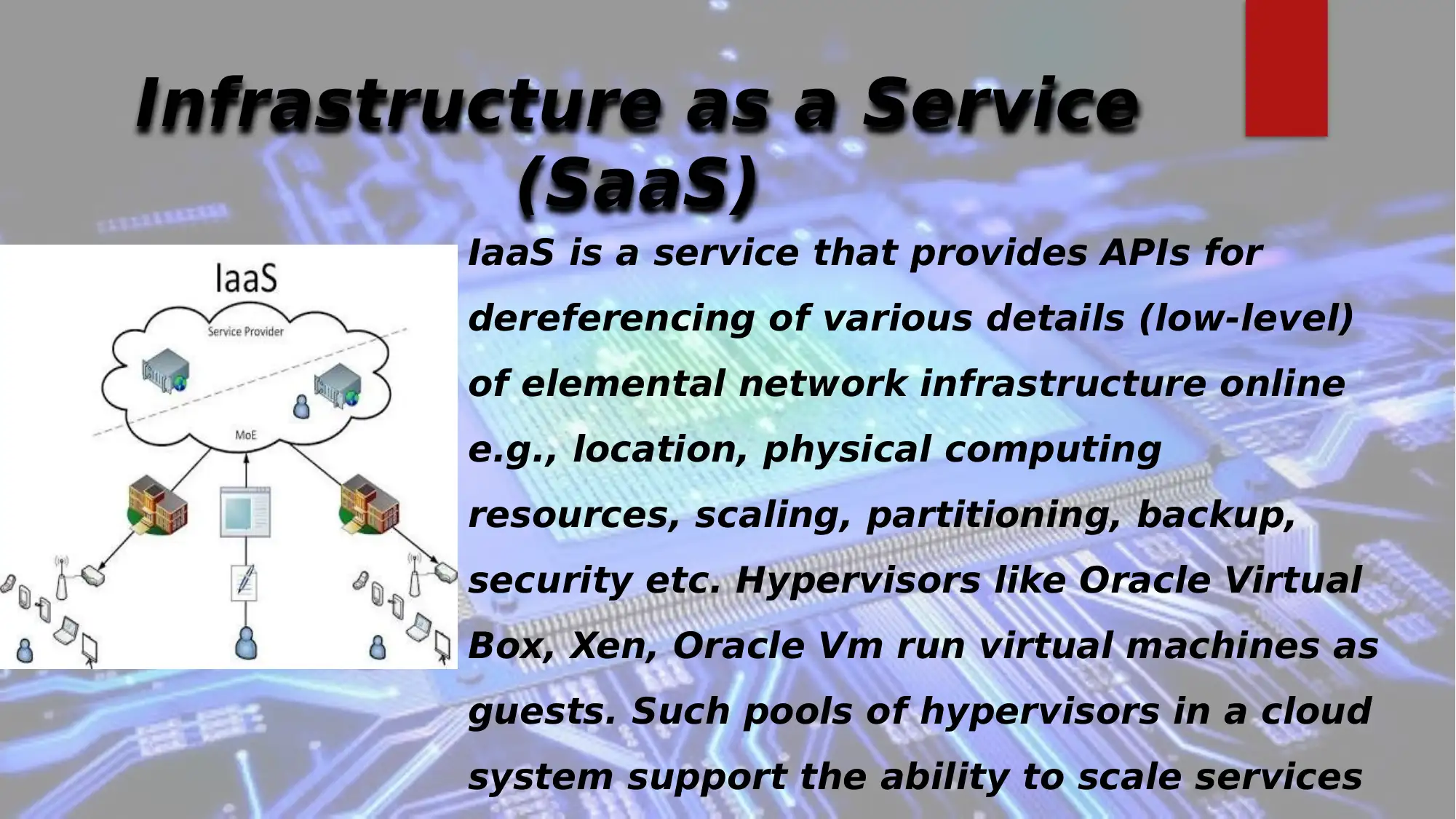
Infrastructure as a Service
(SaaS)
IaaS is a service that provides APIs for
dereferencing of various details (low-level)
of elemental network infrastructure online
e.g., location, physical computing
resources, scaling, partitioning, backup,
security etc. Hypervisors like Oracle Virtual
Box, Xen, Oracle Vm run virtual machines as
guests. Such pools of hypervisors in a cloud
system support the ability to scale services
(SaaS)
IaaS is a service that provides APIs for
dereferencing of various details (low-level)
of elemental network infrastructure online
e.g., location, physical computing
resources, scaling, partitioning, backup,
security etc. Hypervisors like Oracle Virtual
Box, Xen, Oracle Vm run virtual machines as
guests. Such pools of hypervisors in a cloud
system support the ability to scale services
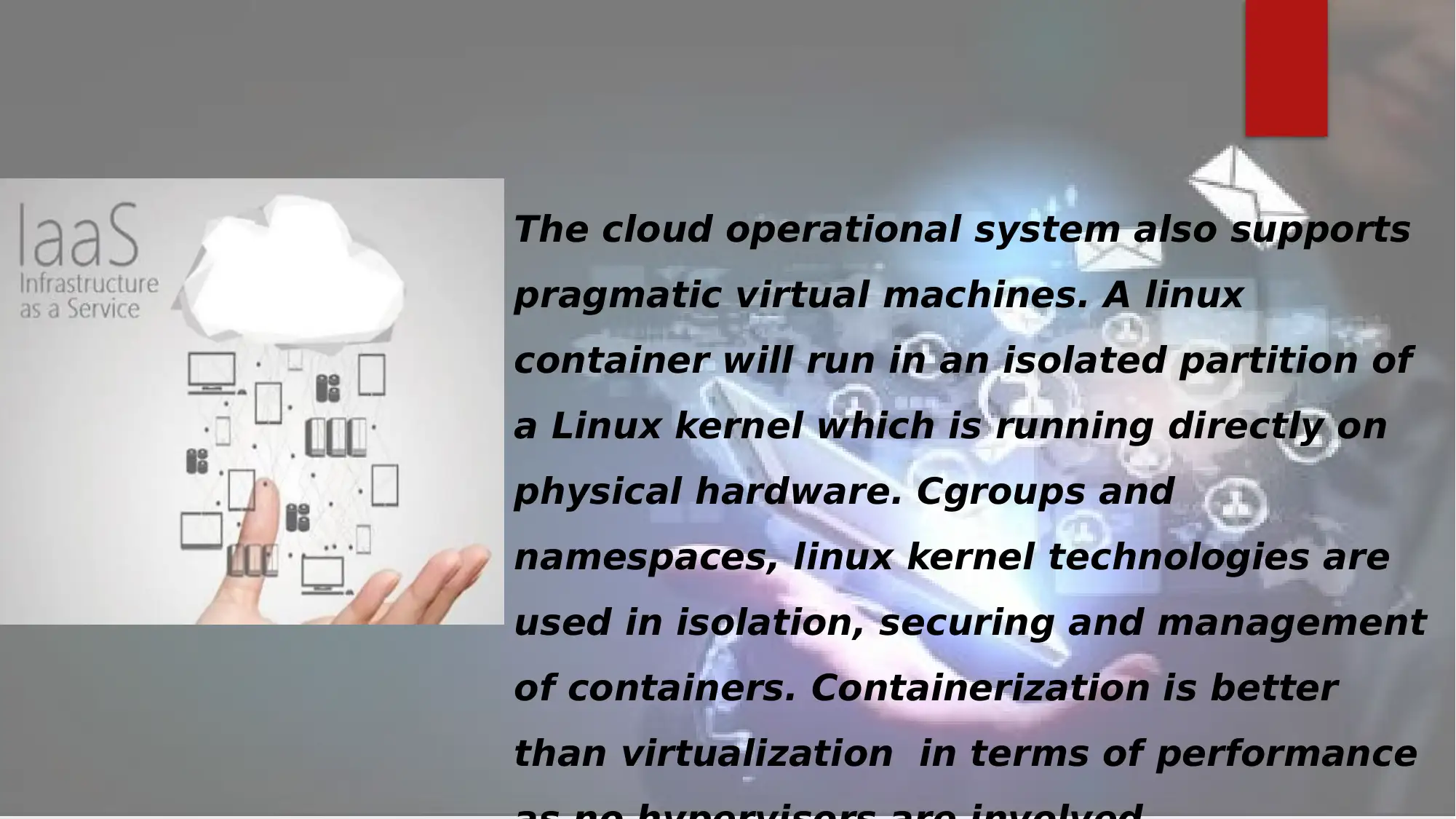
The cloud operational system also supports
pragmatic virtual machines. A linux
container will run in an isolated partition of
a Linux kernel which is running directly on
physical hardware. Cgroups and
namespaces, linux kernel technologies are
used in isolation, securing and management
of containers. Containerization is better
than virtualization in terms of performance
pragmatic virtual machines. A linux
container will run in an isolated partition of
a Linux kernel which is running directly on
physical hardware. Cgroups and
namespaces, linux kernel technologies are
used in isolation, securing and management
of containers. Containerization is better
than virtualization in terms of performance
⊘ This is a preview!⊘
Do you want full access?
Subscribe today to unlock all pages.

Trusted by 1+ million students worldwide

Platform as a Service
Vendors of PaaS offer an appropriate environment,
programming language execution environment, for
application development to developers. A provider
develops standards and the toolkit for development
and the channels for payment and distribution.
Developers can therefore develop, test and run
their applications on a cloud based platform
without having to cover costs of buying physical
hardware needed to run their applications
Vendors of PaaS offer an appropriate environment,
programming language execution environment, for
application development to developers. A provider
develops standards and the toolkit for development
and the channels for payment and distribution.
Developers can therefore develop, test and run
their applications on a cloud based platform
without having to cover costs of buying physical
hardware needed to run their applications
Paraphrase This Document
Need a fresh take? Get an instant paraphrase of this document with our AI Paraphraser
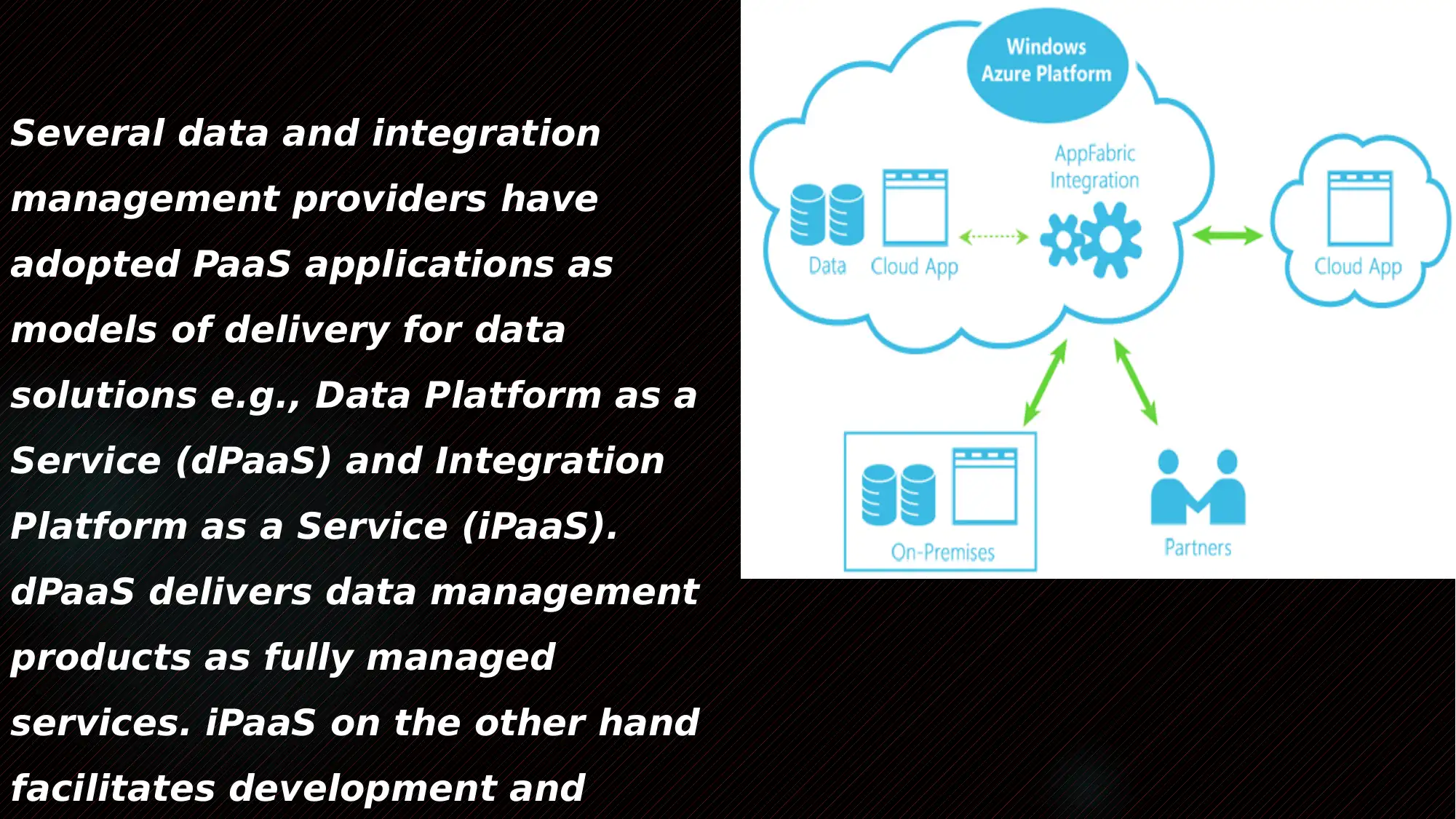
Several data and integration
management providers have
adopted PaaS applications as
models of delivery for data
solutions e.g., Data Platform as a
Service (dPaaS) and Integration
Platform as a Service (iPaaS).
dPaaS delivers data management
products as fully managed
services. iPaaS on the other hand
facilitates development and
management providers have
adopted PaaS applications as
models of delivery for data
solutions e.g., Data Platform as a
Service (dPaaS) and Integration
Platform as a Service (iPaaS).
dPaaS delivers data management
products as fully managed
services. iPaaS on the other hand
facilitates development and

Software as a Service (SaaS)
SaaS also called an ‘on-demand software’ is a
model for software delivery and licensing and
works on a subscription basis, licensing of
software is subscribed for, and all this is
hosted centrally. Providers of the cloud
platform install and operate the software on
cloud, and users are allowed access through
cloud clients. Users don’t manage the platform
or infrastructure on which the application runs.
They therefore don’t have to install the
SaaS also called an ‘on-demand software’ is a
model for software delivery and licensing and
works on a subscription basis, licensing of
software is subscribed for, and all this is
hosted centrally. Providers of the cloud
platform install and operate the software on
cloud, and users are allowed access through
cloud clients. Users don’t manage the platform
or infrastructure on which the application runs.
They therefore don’t have to install the
⊘ This is a preview!⊘
Do you want full access?
Subscribe today to unlock all pages.

Trusted by 1+ million students worldwide
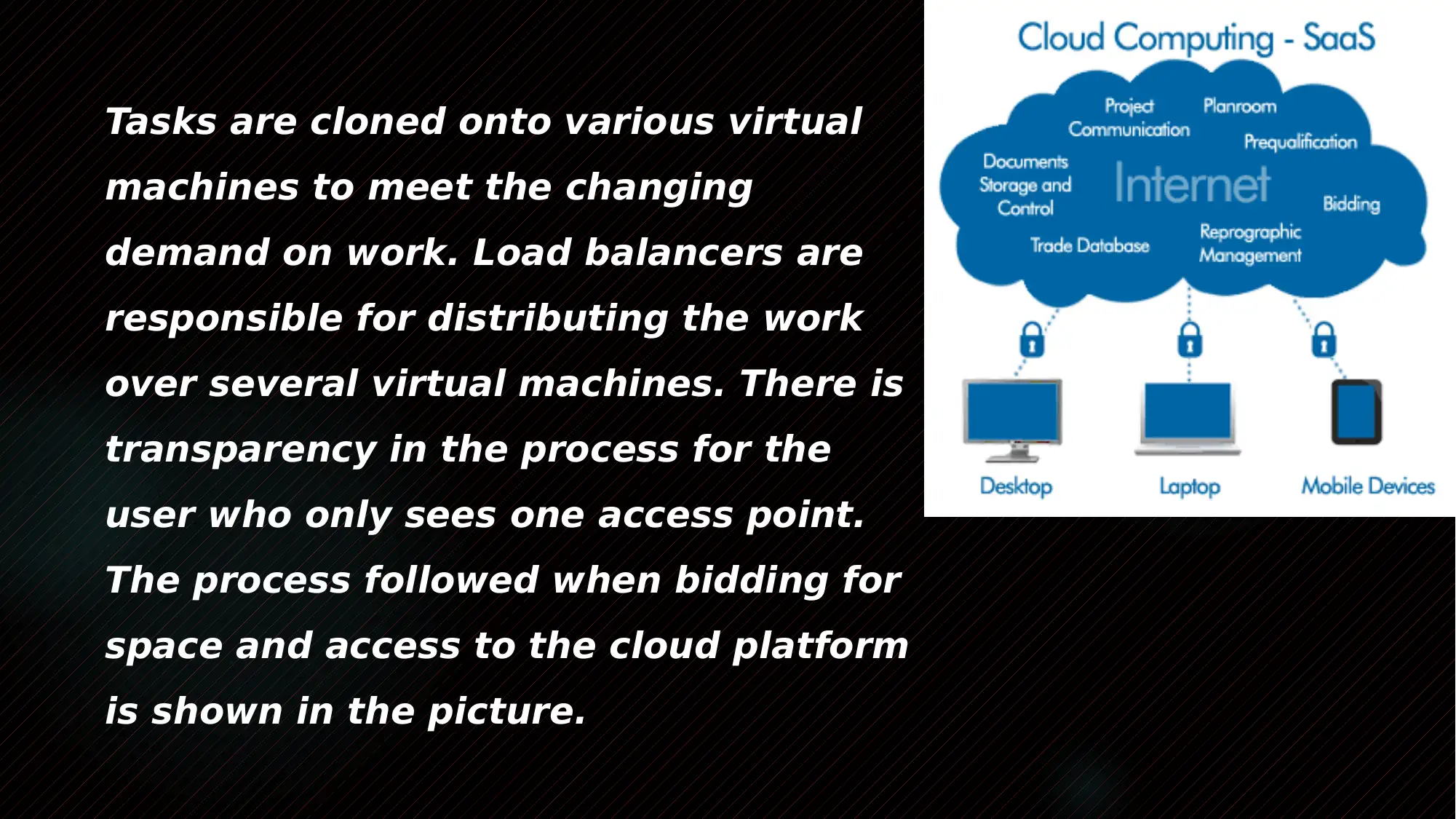
Tasks are cloned onto various virtual
machines to meet the changing
demand on work. Load balancers are
responsible for distributing the work
over several virtual machines. There is
transparency in the process for the
user who only sees one access point.
The process followed when bidding for
space and access to the cloud platform
is shown in the picture.
machines to meet the changing
demand on work. Load balancers are
responsible for distributing the work
over several virtual machines. There is
transparency in the process for the
user who only sees one access point.
The process followed when bidding for
space and access to the cloud platform
is shown in the picture.
Paraphrase This Document
Need a fresh take? Get an instant paraphrase of this document with our AI Paraphraser
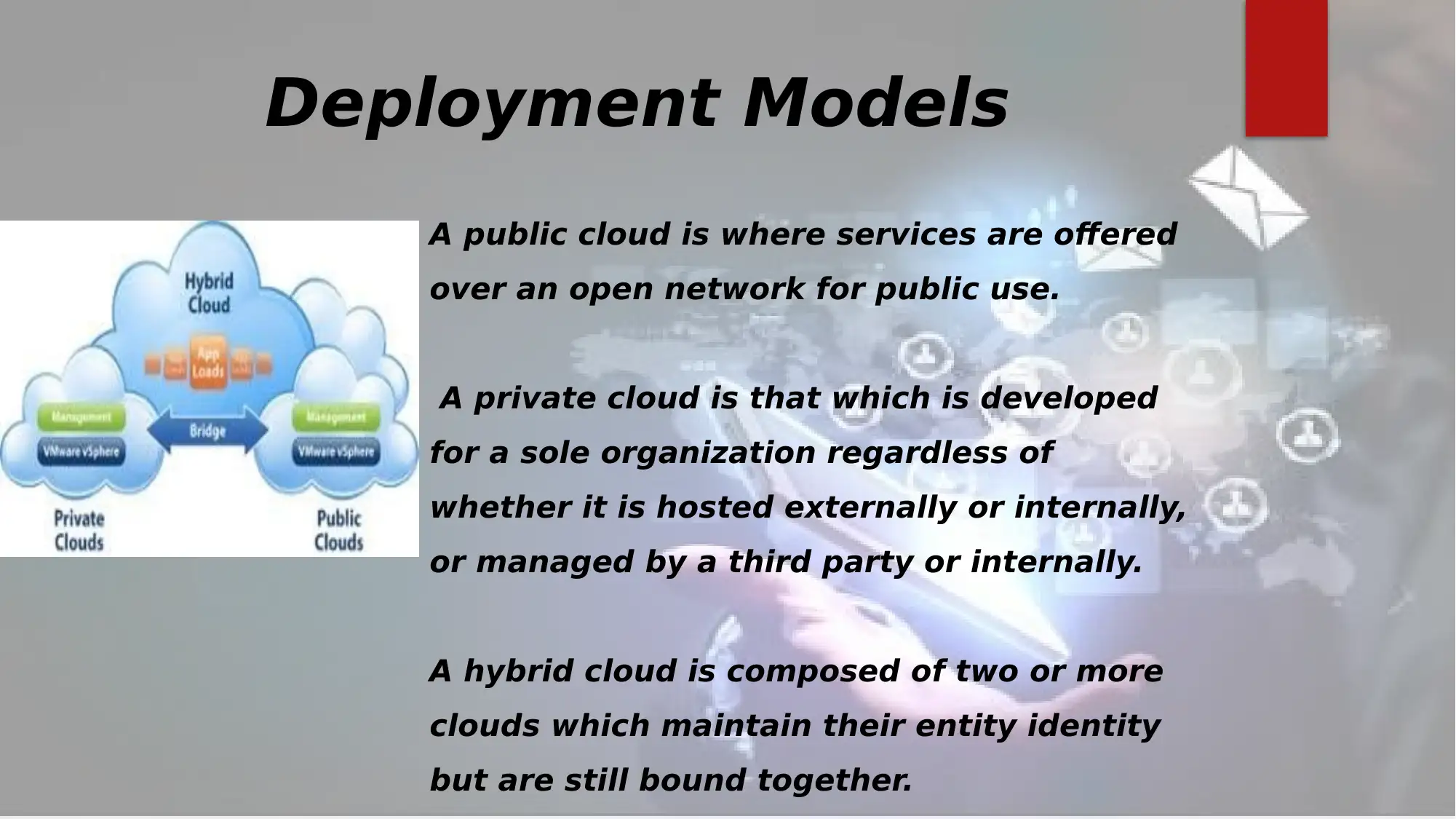
Deployment Models
A public cloud is where services are offered
over an open network for public use.
A private cloud is that which is developed
for a sole organization regardless of
whether it is hosted externally or internally,
or managed by a third party or internally.
A hybrid cloud is composed of two or more
clouds which maintain their entity identity
but are still bound together.
A public cloud is where services are offered
over an open network for public use.
A private cloud is that which is developed
for a sole organization regardless of
whether it is hosted externally or internally,
or managed by a third party or internally.
A hybrid cloud is composed of two or more
clouds which maintain their entity identity
but are still bound together.
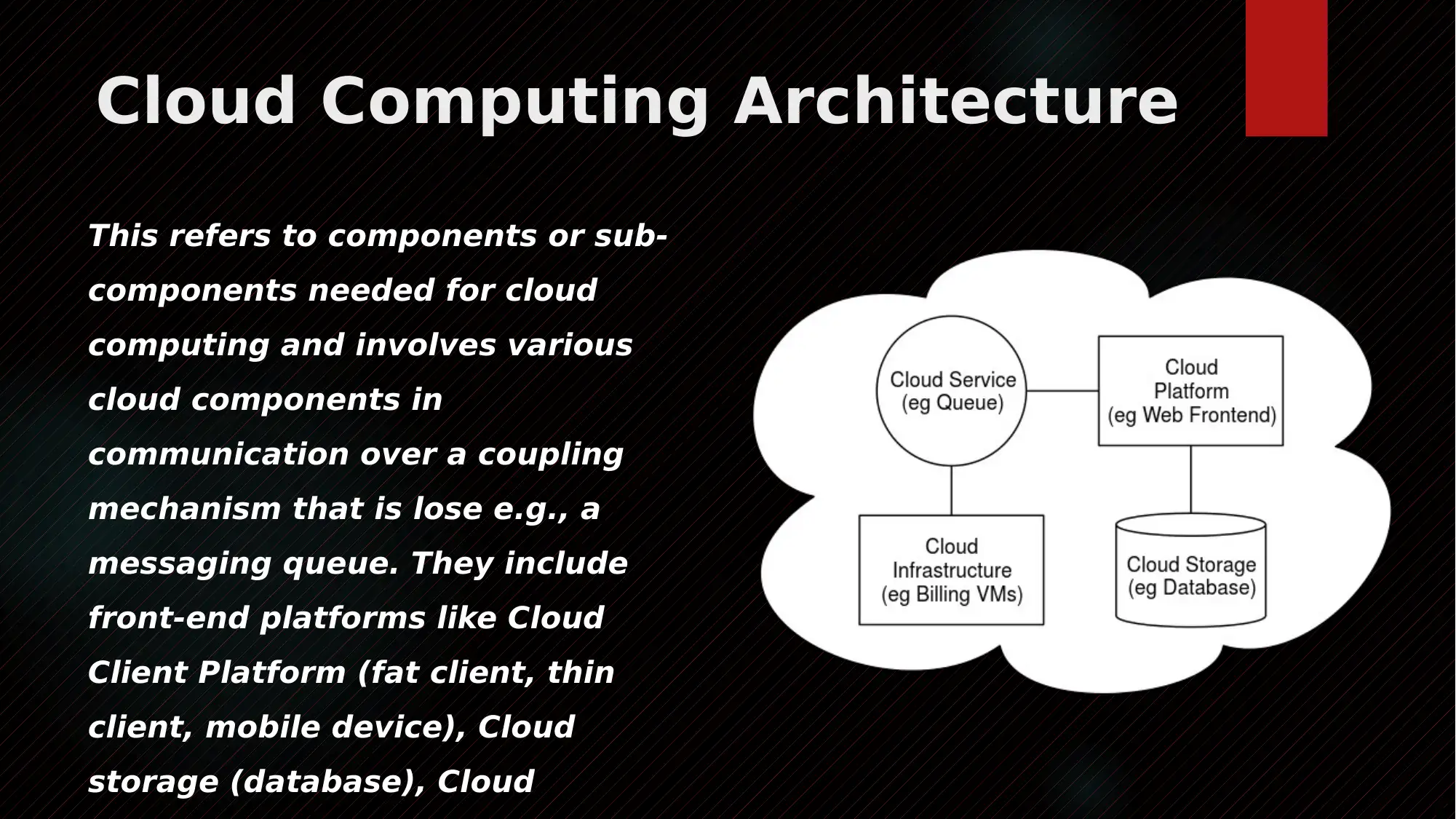
Cloud Computing Architecture
This refers to components or sub-
components needed for cloud
computing and involves various
cloud components in
communication over a coupling
mechanism that is lose e.g., a
messaging queue. They include
front-end platforms like Cloud
Client Platform (fat client, thin
client, mobile device), Cloud
storage (database), Cloud
This refers to components or sub-
components needed for cloud
computing and involves various
cloud components in
communication over a coupling
mechanism that is lose e.g., a
messaging queue. They include
front-end platforms like Cloud
Client Platform (fat client, thin
client, mobile device), Cloud
storage (database), Cloud
⊘ This is a preview!⊘
Do you want full access?
Subscribe today to unlock all pages.

Trusted by 1+ million students worldwide
1 out of 15
Related Documents
Your All-in-One AI-Powered Toolkit for Academic Success.
+13062052269
info@desklib.com
Available 24*7 on WhatsApp / Email
![[object Object]](/_next/static/media/star-bottom.7253800d.svg)
Unlock your academic potential
Copyright © 2020–2025 A2Z Services. All Rights Reserved. Developed and managed by ZUCOL.



